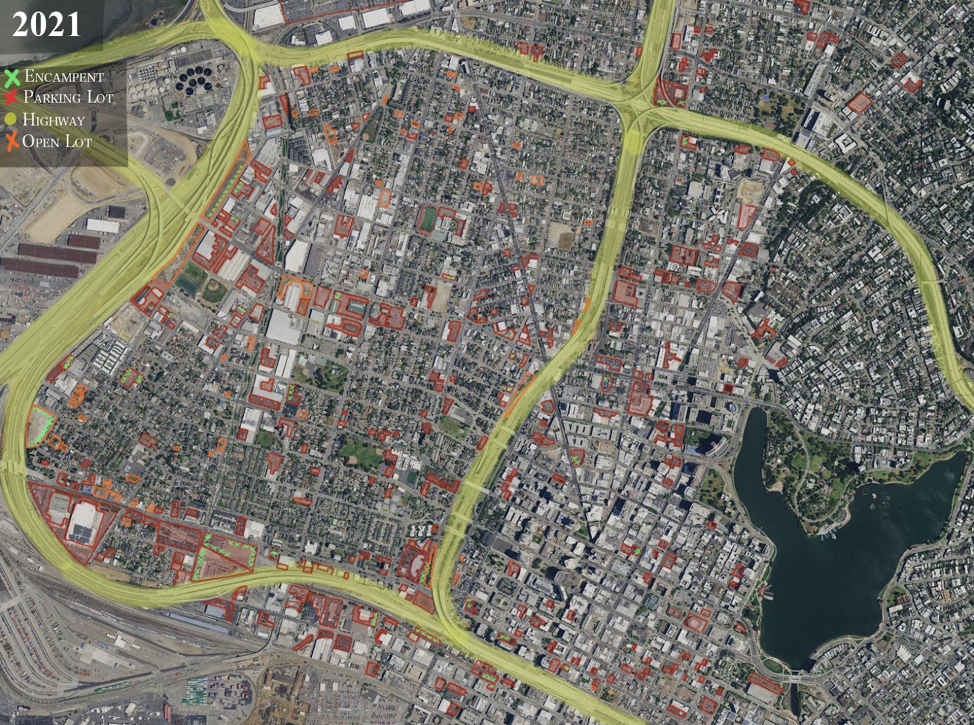⎯⎯Previous Projects⎯⎯

Image credit: Maya Sapienza
DESIGNED ERASURE: MAPPING INFRASTRUCTURE & BLACK URBAN LIFE
Designed Erasure is a mapping and oral history project developed in collaboration with UC Berkeley undergraduate student, Maya Sapienza. The focus of this research project is to explore how race and racialization contribute to the various cycles of development, destruction, and redevelopment in West Oakland. The questions that animate this research are: what does it mean for Black people in Oakland to live through constant cycles of movement, containment, dispossession, and erasure? How can we imagine various forms of displacement and emplacement alongside the mechanisms that attempt to keep Black people in place?
For this project, we will use layered historical maps to document Oakland's planning history, and current policy on homelessness that has been generated by the city of Oakland. In particular, we examine containment, urban renewal infrastructure, architecture, austerity, and homelessness as racialized phenomena. While the project examines connections between urban renewal (as "Negro removal") and contemporary policy that constrains the mobility of the unsheltered and unhoused, we complement this analysis with oral history interviews with current and former Black West Oakland residents, archival photographs, and tax and homeownership records to reimagine a politics of Black placemaking (staying in place) as a way to designate a legible Black future in Oakland. Reclaiming Black West Oakland through a politics of staying in place does not involve simply taking up space, but specifically doing so in response to the systemic silencing and removal of Black people from the Black city and Black spaces. To reclaim space allows us to ask questions and offer narratives of what it means to stay in place, making legitimate claims to space and the meaning of space. Resisting displacement and dispossession is only one part of the story; “staying” opens up the possibility to imagine geographies that were never thought to be seen.
We aim for the project to facilitate engaged scholarship on how narratives about West Oakland emerge and circulate, competing visions for the city’s future and how these evolve over time, and the urban imaginaries that have been forgotten or sidelined in favor of more entrenched interests. The contents of this research (maps, images, accompanying text) will be presented in digital form on an interactive and accessible website. We hope that the visual representation of the various processes of urbanization in Oakland will enable us to make visible the mechanisms undergirding urban inequities.
Funding support for Designed Erasure has been generously provided by the Institute for the Study of Societal Issues (ISSI)

Image credit: Olalekan Jeyifous
THE APOCRYPHAL GOSPEL OF OAKLAND
The Apocryphal Gospel of Oakland (AGO) is a multimedia project developed in collaboration with Nigerian-born, Brooklyn-based visual artist, Olalekan Jeyifous. AGO lampoons policy and power in confronting the housing crisis in Oakland. We envision an absurdist and alternate future that derives from the racist, spurious narratives deployed historically, as justification for “Negro removal” and more recently to explicate “housing scarcity” in the age of the Tech sector boom."Apocrypha" are written works of unknown authorship and dubious authenticity that are nonetheless widely circulated as being “true” (The Gospel).
On the topic of California’s ongoing homeless and housing crisis, the prevailing “Apocrypha” of Oakland is “housing scarcity,” despite findings by the American Community Survey that show there are four vacant units for every unhoused person. Municipal powers frame, react, and derive policy based on this notion of scarcity to address rampant homelessness, and to promote the idea that developing more "affordable” housing is the only solution to a crisis that derived from ongoing economic, racial, and political inequities. As a result, often untenable, even preposterous interim and emergency “transitional housing” strategies are presented as viable solutions. An emphasis and aggrandizement of these “strategies” as speculative urban interventions form the basis of our project.
“The Apocryphal Gospel of Oakland” is a multimedia installation comprised of hyper-real, Dystopian images, infographics, and animations re-imagined at the intersection of artistic abstraction and the exploratory potential for statistical analysis as a form of accountability and cutting social critique. The primary focus of this project will be photo-montages and experimental video depicting exaggerated “future” encampments from an alternate reality. Archival photographs, abstracted maps, and inventive animations will tell the origin story of these speculative encampments, reflecting on the socio-spatial organizational policies, cultural phenomena, contexts, and events that defined their establishment, tracing back to the racialized history of segregation and dispossession that justified the destruction of Black neighborhoods under the pretense of “urban renewal.”
